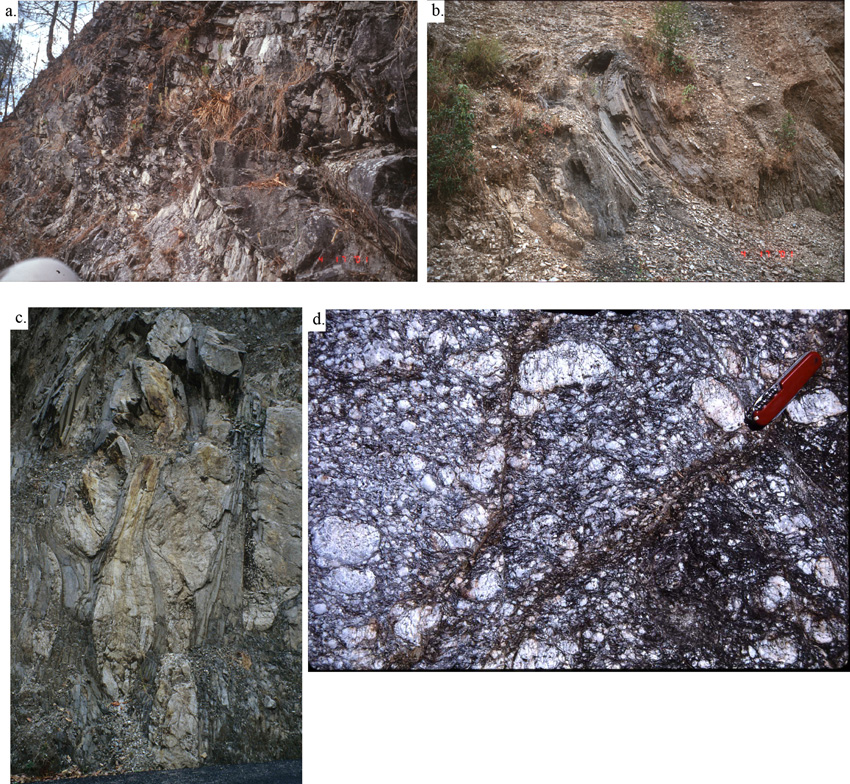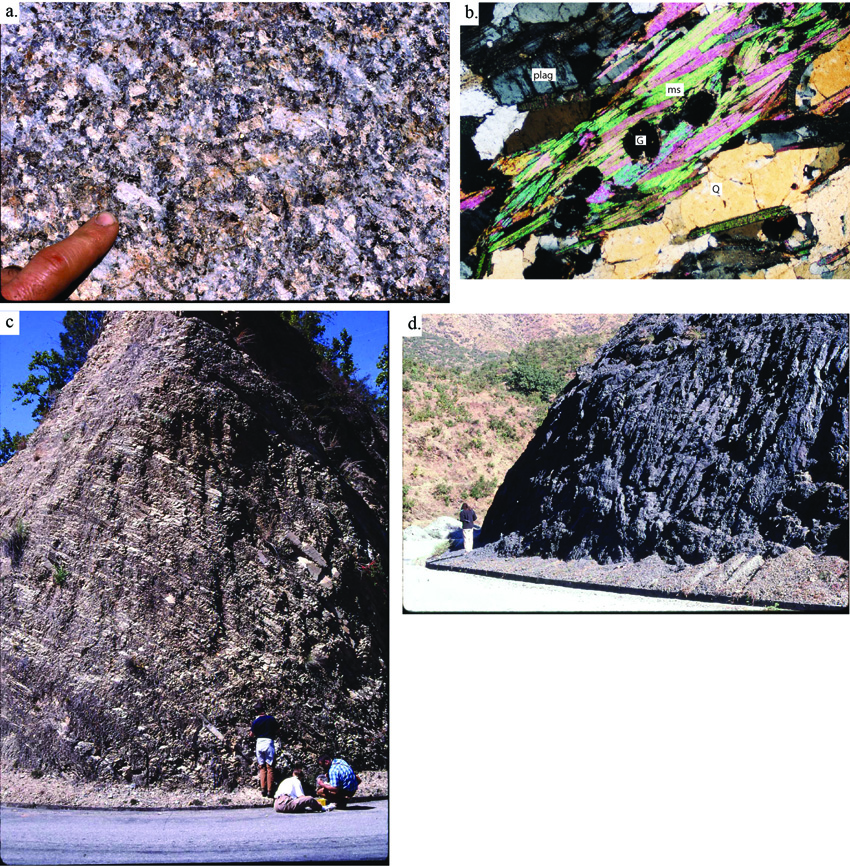DAY 3. Lesser Himalayan Imbricate Zone, Ramgarh-Munsiari Thrust Sheet, Dadeldhura Klippe
Sangram Formation
The Sangram Formation as mapped by Shrestha et al. (1987a) in far-western Nepal is ~500 m thick and consists of a lower quartzite interval and an upper fine-grained interval, although this unit may be the Kushma Formation. The quartzite is locally referred to as the Budar quartzite, and is a white, sugary, medium-grained, orthoquartzite. However, the detrital zircon spectra of the Budar quartzite (Gehrels et al., 2011) is similar to age spectra from quartzites in the lower part of the Lesser Himalayan sequence, particularly the Kuncha Formation in central Nepal (Martin et al., 2011). The main age peaks in the Kuncha Formation and Budar quartzite are between 1900 Ma and1960 Ma, and the complete age spectra are nearly identical. This calls into question the correlation from Shrestha et al. (1987a) that the Budar quartzite is within the Sangram Formation. Instead, the detrital zircon spectra is more similar to the Kushma Formation, the oldest LH unit in far-western Nepal. The Budar quartzite is a ridge former, but is thinner and less well-indurated than the Kushma Formation. Overlying the Budar are black argillite, brown phyllite, and thin, white to pink quartzite with occasional pebbly layers. These units are slope-formers and generally not well exposed.
Small-scale structures in the Sangram Formation are common and include small folds and faults in thinly bedded quartzite layers. Detrital zircons extracted from the Sangram Formation are dominated by ages ~1.68 Ga, indicating that the Sangram must be younger than that age (DeCelles et al., 2000). The upper contact is gradational into the Galyang Formation. The Sangram Formation along the road is pervasively folded and faulted (Fig. 6a; N29º06’24.5”; E80º34’24”; 1535±54 m).
Figure 6. Along the Dadeldhura Road

a) Fold nose in the Budar quartzite along the Dadeldhura Road. Robinson et al. (2006) interpreted this unit as the Sangram Formation. However, the detrital zircon age spectrum of this sample (Gehrels et al., 2011) is similar to the type Kuncha Formation spectrum in central Nepal (Martin et al., 2011) in all respects. The main peak in the type Kuncha Formation is at 1900 Ma and in the Budar quartzite at 1960 Ma. (b) Varigated shales, quartzite, and dolostone of the Syangia Formation are deformed in the footwall of the southern trace of the RMT along the Dadeldhura Road. (N29°06’24.5”; E80°34’24.0”; 1535±54 m). (c) Quartzite and phyllite in the immediate hangingwall of the RMT along the Dadeldhura Road (N29°08’36.0”; E80°34’51.4”; 1762±67 m). (d) The Budiganga gneiss in the north limb of the Dadeldhura klippe has an 40Ar/39Ar age of 21.1±0.2 Ma (DeCelles et al., 2001). 5 cm knife for scale.
Syangia Formation
Farther north along the road are roadcuts in interbedded purple quartzite and shale of the Syangia Formation. The Syangia Formation in far-western Nepal contains a wide variety of lithologies including: green phyllite; reddish, purple and green slate; pink, white and maroon thinly bedded quartzite; and thinly bedded blue and white dolostone and limestone (Fig. 6b). Along the Seti River, southwest of Chainpur, black slate and stretched pebble conglomerate are present in the formation. Thickness of the Syangia Formation is ~500 m in far-western Nepal. DeCelles et al. (2001) reported that the Syangia Formation was deposited after 1680 Ma; however, Gehrels et al. (2011) re-analysed the sample and it yielded a maximum depositional age of 1825 Ma. The upper contact of the Syangia Formation is transitional with the overlying Lakharpata Group. The cross-section (Fig. 3a) shows a thrust fault that has been reactivated as a normal fault between the Sangram and Syangia Formations.
The Ramgarh-Munsiari Thrust Sheet South of the Dadeldhura Klippe
The Ramgarh-Munsiari thrust (RMT) in different parts of Nepal carries the lowermost LH Paleoproterozoic rocks (Robinson and Pearson, 2013). The RMT sheet is folded in a syncline underneath the Dadeldhura klippe. Exposures along the road are mainly from the Ranimata Formation but there are some quartzite beds within the units and some augen gneiss exposures. However, we defer description of the Kushma Formation and the Proterozoic augen gneiss until the units are encountered south of the Main Central thrust.
The RMT is exposed along the road, where it juxtaposes vertical beds of the Ranimata Formation against quartzite of the Syangia Formation (Fig. 6b). Along the road, the Ranimata Formation is mixed with quartzite beds (Kushma Formation?) over a distance of ~5 km (Fig. 6c). The Ranimata Formation was intruded by the Gaira orthogneiss, which may be a Proterozoic augen gneiss, and some dioritic intrusions. The interbedded quartzite and phyllite with some faulting and folding are exposed at the village of Goganpani (Fig. 6c; N29º08’36.0”; E80º24’51.4”; 1762±67 m).
Ranimata Formation
The Ranimata Formation is a green chloritic phyllite with occasional 10-100 m thick intervals of thinly bedded white to green quartzite and rare thinly bedded carbonates (~20 m thick). Dark green chloritic zones and quartz augen are interspersed throughout the formation. Mineralogic composition includes quartz + muscovite (sericite) + biotite + chlorite ± amphibole ± garnet ± staurolite. Small-scale structures include dissolution and crenulation cleavage and small folds. Dioritic intrusions, including amphibolite, occur throughout the Ranimata Formation in western Nepal. Thickness of the formation ranges from 1.5 km in far-western Nepal to 2-3 km in mid-western Nepal; however, thickness and composition of the Ranimata Formation vary considerably along strike. The Ranimata Formation weathers readily to form wide valleys used for agriculture. In central Nepal, the upper contact is conformable with the Fagfog Formation (Sangram Formation equivalent; DeCelles et al., 2001). Although the upper contact has always been observed as a fault in western Nepal, the stratigraphic relationship in central Nepal and detrital zircons from the overlying Sangram Formation suggest that the Ranimata Formation may be transitional with the Sangram Formation (Martin et al., 2011).
The Dadeldhura Klippe
The Dadeldhura klippe is one of the so-called LH crystalline nappes. It is an erosional outlier of medium- to high-grade metamorphic rocks similar to GH rocks (Gansser, 1964; Stöcklin, 1980; Upreti and Le Fort, 1999). The Dadeldhura klippe contains schist, migmatitic gneiss (Fig. 6d), calcsilicate gneiss, metavolvanic rocks, orothogneiss, and granite (Fig. 7a) (Gannser, 1964; Fuchs, 1981; Arita et al., 1984; Bashyal, 1986; Upreti, 1990; DeCelles et al., 2001). The Kalikot Schist is fine- to coarse-grained with a mineral assemblage of quartz + biotite + muscovite + plagioclase feldspar + potassium feldspar +garnet ± kyanite ± tourmaline ± zircon (Fig. 7b). The Budhiganga Gneiss is a coarse-grained augen gneiss containing quartz + plagioclase feldspar + potassium feldspar + biotite + muscovite + garnet ± apatite (Fig. 6d). Similar minerals are also present in the mylonitic augen gneiss of the Salyanigad Gneiss, which may be contiguous with the Budhiganga Gneiss. The Salyanigad Gneiss yielded a concordant U-Pb zircon age of 478 ±10 Ma (DeCelles et al., 2000). This gneiss surrounds the Dadeldhura granite, which yielded a concordant U-Pb zircon age of 492 ± 6 Ma (DeCelles et al., 1998a) and 470 ± 5.6 Ma (Einfalt et al., 1993), suggesting that the Salyanigad Gneiss is a ductilely deformed envelope around the Dadeldhura granite. The age and mineral assemblage of the granites and gneiss are similar to those of GH unit III orthogneiss. Calcsilicate rocks are also present in the Dadeldhura klippe with a mineral assemblage of calcite + quartz + plagioclase + potassium feldspar + hornblende ± tourmaline ± epidote. The Dadeldhura klippe is ~6 km thick (DeCelles et al., 2001), although this is most likely a remnant of the original thickness of the klippe. DeCelles et al. (2001) reported an 40Ar/39Ar muscovite cooling age of ca. 21 Ma in the Budhiganga gneiss (sample SR40; DeCelles et al., 2001) from the northern limb of the Dadeldhura klippe. Robinson et al. (2006) reported an 40Ar/39Ar muscovite cooling age of ca. 25 Ma in the hanging wall of the MCT sheet (sample SR124).
Figure 7. Dadeldhura granite, Dadeldhura klippe and Melmura and Damgad Fms

(a) Dadeldhura Granite with a U-Pb age of 492±6 Ma (DeCelles et al., 2001), finger for scale. (b) Photomicrograph of the Kalikot Schist of the Dadeldhura klippe, biotite (bi) and muscovite (ms) surrounding garnet (G) plus plagioclase (plag) and quartz (Q). Field of view is ~9 mm. (c) Melmura Formation, graphitic-carbonaceous rock along the Dadeldhura-Dipayal road with person at left for scale. (d) Damgad Formation, thin-bedded quartzite cropping out along the Dadeldhura-Dipayal with people for scale (N29°23’5.5”; E80°37’12.7”).
An option that adds 4-5 hours to travel time in the Dadeldhura klippe is to travel to the east along the Dipayal Road to see Tibetan Himalayan (TH) rocks. Paleozoic sedimentary rocks related to the Tethyan sequence unconformably overlie metamorphic rocks in the Dadeldhura klippe (Fig. 2). The Melmura Formation, regarded by Shrestha et al. (1987a) as a Tethyan unit, consists of thinly bedded brown phyllite, brown and white intercalated quartzite, and graphitic slate (Fig. 7c). The Damgad Formation (Fig. 7d), with a basal ~30 m thick conglomerate, rests in angular unconformity on top of the Melmura Formation (Gehrels et al., 2003). Lithologies in the Damgad Formation include fine- to medium-grained cross-stratified quartzite and occasional brown phyllite. However, Antolin et al. (2013) suggest that the TH rock in the klippe is bounded at the base by the STDS, rather than an unconformable contact.
Camping/lodging at Dadeldhura for the night (Camp 3 on Fig. 2).